 Полная версия
Полная версияOn the various forces of nature and their relations to each other
Now, besides this production of light, we have all the other effects and powers of burning zinc. I have a few wires here which are not combustible, and I am going to take one of them, a small platinum wire, and suspend it between these two rods, which are connected with the battery; and, when contact is made at the battery, see what heat we get (fig. 48). Is not that beautiful? – it is a complete bridge of power. There is metallic connection all the way round in this arrangement; and where I have inserted the platinum, which offers some resistance to the passage of the force, you see what an amount of heat is evolved, – this is the heat which the zinc would give if burnt in oxygen; but as it is being burnt in the voltaic battery, it is giving it out at this spot. I will now shorten this wire for the sake of shewing you, that the shorter the obstructing wire is, the more and more intense is the heat, until at last our platinum is fused and falls down, breaking off the circuit.
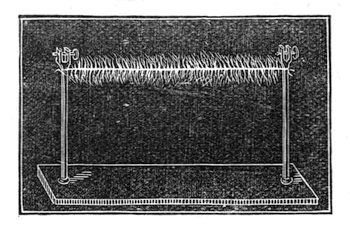
Fig. 48.
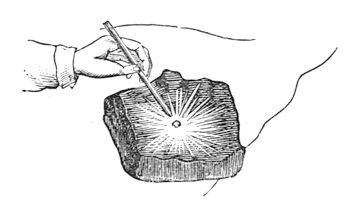
Fig. 49.]
Here is another instance. I will take a piece of the metal silver, and place it on charcoal, connected with one end of the battery, and lower the other charcoal pole on to it. See how brilliantly it burns (fig. 49). Here is a piece of iron on the charcoal – see what a combustion is going on; and we might go on in this way, burning almost everything we place between the poles. Now, I want to shew you that this power is still chemical affinity – that if we call the power which is evolved at this point heat, or electricity, or any other name referring to its source, or the way in which it travels, we still shall find it to be chemical action. Here is a coloured liquid which can shew by its change of colour the effects of chemical action. I will pour part of it into this glass, and you will find that these wires have a very strong action. I am not going to shew you any effects of combustion or heat; but I will take these two platinum plates, and fasten one to the one pole, and the other to the other end, and place them in this solution, and in a very short time you will see the blue colour will be entirely destroyed. See, it is colourless now! – I have merely brought the end of the wires into the solution of indigo, and the power of electricity has come through these wires, and made itself evident by its chemical action. There is also another curious thing to be noticed, now we are dealing with the chemistry of electricity, which is, that the chemical power which destroys the colour is only due to the action on one side. I will pour some more of this sulpho-indigotic acid24 into a flat dish, and will then make a porous dyke of sand, separating the two portions of fluid into two parts (fig. 50); and now we shall be able to see whether there is any difference in the two ends of the battery, and which it is that possesses this peculiar action. You see it is the one on my right hand which has the power of destroying the blue – for the portion on that side is thoroughly bleached – while nothing has apparently occurred on the other side. I say apparently, for you must not imagine that, because you cannot perceive any action, none has taken place.

Fig. 50.
Here we have another instance of chemical action. I take these platinum plates again, and immerse them in this solution of copper, from which we formerly precipitated some of the metal, when the platinum and zinc were both put in it together. You see that these two platinum plates have no chemical action of any kind – they might remain in the solution as long as I liked, without having any power of themselves to reduce the copper; – but the moment I bring the two poles of the battery in contact with them, the chemical action, which is there transformed into electricity and carried along the wires, again becomes chemical action at the two platinum poles; and now we shall have the power appearing on the left-hand side, and throwing down the copper in the metallic state on the platinum plate; and in this way I might give you many instances of the extraordinary way in which this chemical action, or electricity, may be carried about. That strange nugget of gold, of which there is a model in the other room – and which has an interest of its own in the natural history of gold, and which came from Ballarat, and was worth £8,000, or £9,000, when it was melted down last November – was brought together in the bowels of the earth, perhaps ages and ages ago, by some such power as this. And there is also another beautiful result dependent upon chemical affinity in that fine lead-tree25– the lead growing and growing by virtue of this power. The lead and the zinc are combined together in a little voltaic arrangement, in a manner far more important than the powerful one you see here; because, in nature, these minute actions are going on for ever, and are of great and wonderful importance in the precipitation of metals and formation of mineral veins, and so forth. These actions are not for a limited time, like my battery here, but they act for ever in small degrees, accumulating more and more of the results.
I have here given you all the illustrations that time will permit me to shew you of chemical affinity producing electricity, and electricity again becoming chemical affinity. Let that suffice for the present, and let us now go a little deeper into the subject of this chemical force, or this electricity – which shall I name first – the one producing the other in a variety of ways? These forces are also wonderful in their power of producing another of the forces we have been considering, namely, that of magnetism; and you know that it is only of late years, and long since I was born, that the discovery of the relations of these two forces of electricity and chemical affinity to produce magnetism have become known. Philosophers had been suspecting this affinity for a long time, and had long had great hopes of success; for in the pursuit of science we first start with hopes and expectations. These we realise and establish, never again to be lost, and upon them we found new expectations of further discoveries, and so go on pursuing, realising, establishing, and founding new hopes again and again.

Fig. 51.
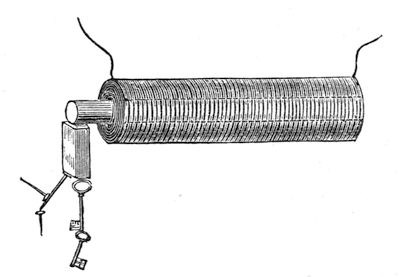
Fig. 52.
Now, observe this: here is a piece of wire which I am about to make into a bridge of force – that is to say, a communicator between the two ends of the battery. It is copper wire only, and is therefore not magnetic of itself. We will examine this wire with our magnetic needle (fig. 51); and though connected with one extreme end of the battery, you see that, before the circuit is completed, it has no power over the magnet. But observe it when I make contact; watch the needle – see how it is swung round, and notice how indifferent it becomes if I break contact again; so you see we have this wire evidently affecting the magnetic needle under these circumstances. Let me shew you that a little more strongly. I have here a quantity of wire, which has been wound into a spiral; and this will affect the magnetic needle in a very curious manner, because, owing to its shape, it will act very like a real magnet. The copper spiral has no power over that magnetic needle at present; but if I cause the electric current to circulate through it, by bringing the two ends of the battery in contact with the ends of the wire which forms the spiral, what will happen? Why, one end of the needle is most powerfully drawn to it; and if I take the other end of the needle, it is repelled: so you see I have produced exactly the same phenomena as I had with the bar magnet, – one end attracting, and the other repelling. Is not this, then, curious, to see that we can construct a magnet of copper? Furthermore, if I take an iron bar, and put it inside the coil, so long as there is no electric current circulating round, it has no attraction, – as you will observe if I bring a little iron filings or nails near the iron. But now, if I make contact with the battery, they are attracted at once. It becomes at once a powerful magnet – so much so, that I should not wonder if these magnetic needles on different parts of the table pointed to it. And I will shew you by another experiment what an attraction it has. This piece and that piece of iron, and many other pieces, are now strongly attracted (fig. 52); but as soon as I break contact, the power is all gone, and they fall. What, then, can be a better or a stronger proof than this of the relation of the powers of magnetism and electricity? Again, here is a little piece of iron which is not yet magnetised. It will not at present take up any one of these nails; but I will take a piece of wire and coil it round the iron (the wire being covered with cotton in every part, it does not touch the iron), so that the current must go round in this spiral coil. I am, in fact, preparing an electro-magnet (we are obliged to use such terms to express our meaning, because it is a magnet made by electricity – because we produce by the force of electricity a magnet of far greater power than a permanent steel one). It is now completed, and I will repeat the experiment which you saw the other day, of building up a bridge of iron nails. The contact is now made, and the current is going through; it is now a powerful magnet. Here are the iron nails which we had the other day; and now I have brought this magnet near them, they are clinging so hard that I can scarcely move them with my hand (fig. 53). But when the contact is broken, see how they fall. What can shew you better than such an experiment as this the magnetic attraction with which we have endowed these portions of iron? Here, again, is a fine illustration of this strong power of magnetism. It is a magnet of the same sort as the one you have just seen. I am about to make the current of electricity pass through the wires which are round this iron for the purpose of shewing you what powerful effects we get. Here are the poles of the magnet; and let us place on one of them this long bar of iron. You see, as soon as contact is made, how it rises in position (fig. 54); and if I take such a piece as this cylinder, and place it on, woe be to me if I get my finger between: I can roll it over, but if I try to pull it off, I might lift up the whole magnet; but I have no power to overcome the magnetic power which is here evident. I might give you an infinity of illustrations of this high magnetic power. There is that long bar of iron held out; and I have no doubt that, if I were to examine the other end, I should find that it was a magnet. See what power it must have to support not only these nails but all those lumps of iron hanging on to the end. What, then, can surpass these evidences of the change of chemical force into electricity, and electricity into magnetism? I might shew you many other experiments whereby I could obtain electricity and chemical action, heat and light, from a magnet; but what more need I shew you to prove the universal correlation of the physical forces of matter, and their mutual conversion one into another?
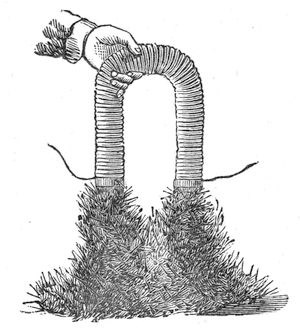
Fig. 53.
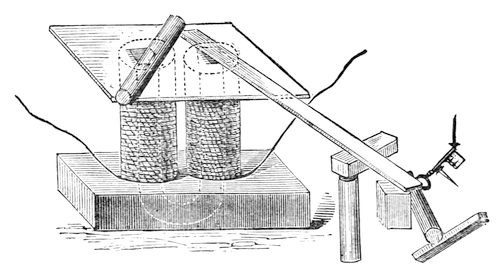
Fig. 54.
And now, let us give place, as juveniles, to the respect we owe to our elders; and for a time let me address myself to those of our seniors who have honoured me with their presence during these lectures. I wish to claim this moment for the purpose of tendering our thanks to them, and my thanks to you all, for the way in which you have borne the inconvenience that I at first subjected you to. I hope that the insight which you have here gained into some of the laws by which the universe is governed, may be the occasion of some amongst you turning your attention to these subjects; for what study is there more fitted to the mind of man than that of the physical sciences? And what is there more capable of giving him an insight into the actions of those laws, a knowledge of which gives interest to the most trifling phenomenon of nature, and makes the observing student find —
“ – tongues in trees, books in the running brooks,
Sermons in stones, and good in everything?”
LECTURE ON LIGHT-HOUSE ILLUMINATION – THE ELECTRIC LIGHT
[Delivered before the Royal Institution on Friday, 9th March, 1860.]There is no part of my life which gives me more delight than my connection with the Trinity House. The occupation of nations joined together to guide the mariner over the sea, to all a point of great interest, is infinitely more so to those who are concerned in the operations which they carry into effect; and it certainly has astonished me, since I have been connected with the Trinity House, to see how beautifully and how wonderfully shines forth amongst nations at large the desire to do good; and you will not regret having come here to-night, if you follow me in the various attempts which have been made to carry out the great object of guiding in safety all people across the dark and dreary waste of waters. It is wonderful to think how eagerly efforts at improvement are made by the various public bodies – the Trinity House in this country, and Commissions in France and other nations; and whilst the improvements progress, we come to the knowledge of such curious difficulties, and such odd modes of getting over those difficulties, as are not easy to be conceived. I must ask you this evening to follow me from the simplest possible method of giving a sign by means of a light to persons at a distance, to the modes at which we have arrived in the present day; and to consider the difficulties which arise when carrying out these improvements to a practical result, and the extraordinary care which those who have to judge on these points must take in order to guard against the too hasty adoption of some fancied improvement, thus, as has happened in some few cases, doing harm instead of good.
If I try to make you understand these things partly by old models, and partly by those which we have here, it is only that I may the better be enabled to illustrate that which I look forward to as the higher mode of lighting, by means of the electric lamp and the lime light.
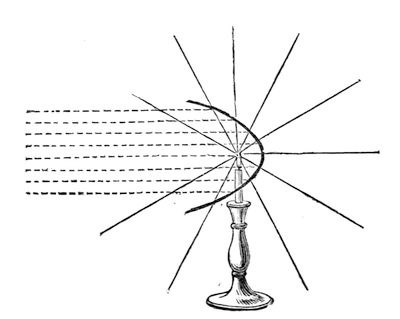
Fig. 55.
There is nothing more simple than a candle being set down in a cottage window to guide a husband to his home; but when we want to make a similar guide on a large scale, not merely over a river or over a moor, but over large expanses of sea, how can we then make the signal, using only a candle? I have shewn in this diagram (fig. 55) what we may imagine to be the rays of a candle or any other source of light emanating from the centre of a sphere in all directions round to infinite distances. After this simple kind of light had been used for some time – it being found to be liable to be obscured by fogs, or distance, or other circumstance – there arose the attempt to make larger lights by means of fires; and after that there was introduced a very important refinement in the mode of dealing with the light, namely, the principle of reflection, – for, understand this (which is not known by all, and not known by many who should know it), that when we take a source of light – a single candle, for instance, giving off any quantity of light – we can by no means increase that light: we can make arrangements around and about the light, as you see here, but we can by no means increase the quantity of light. The utmost I can do is to direct the light which the lamp gives me by taking a certain portion of the rays going off on one side and reflecting them on to the course of the rays which issue in the opposite direction. First of all, let us consider how we may gather in the rays of light which pass off from this candle. You will easily see that if I could take the half-rays on the one side, and could send them by any contrivance over to the other side, I should gain an advantage in light on the side to which I directed them. This is effected in a beautiful manner by the parabolic mirror, by means of which I gather all that portion of the rays which are included in it – upwards, downwards, sideways, anywhere within its sphere of action: they are all picked up and sent forward. You thus see what a beautiful and important invention is that of the parabolic reflector for throwing forward the rays of light.

Fig. 56.
Before I go further into the subject of reflection, let me point out a further mode of dealing with the direction of the light. For instance, here is a candle, and I can employ the principle of refraction to bend and direct the rays of light; and if I want to increase the light in any one direction, I must either take a reflector or use the principle of refraction. I will place this lens (fig. 56) in front of the candle, and you will easily see that by its means I can throw on to that sheet of paper a great light; that is to say, that instead of the light being thrown all about, it is refracted and concentrated on to that paper. So here I have another means of bending the light and sending it in one direction; and you see above a still better arrangement for the same purpose, – one which comes up to the maximum, I may say, of the ability of directing light by this means. You are aware that without that arrangement of glass the light would be dispersed in all directions; but the lens being there, all the light which passes through it is thrown into parallel beams and cast horizontally along. There is consequently no loss of light – the beam goes forward of the same dimensions, and will consequently continue to go forward for five or ten miles, or so long as the imperfection of the atmosphere does not absorb it: and see, what a glorious power that is, to be able to convert what was just now darkness on that paper into brilliant light!
Whenever we have refraction of this sort, we are liable to an evil consequent upon the necessary imperfections in the form of the lens; and Dr. Tyndall will take this lens, and will shew you even in this small and perfect apparatus what is the evil of spherical aberration with which we have to fight. This can be illustrated by means of the electric lamp: if you look at the screen, you will see produced, by means of this lens, a figure of the coal points. This image is produced by the rays which pass through the middle of the lens, a piece of card with a hole in the centre being placed in front; but if, keeping the rest of the apparatus in the same position, I change this card for another piece which will only allow the rays to pass through the edge of the lens, you observe how inferior the image will be. In order to get it distinct, I have to bring the screen much nearer the lamp; and so, if I take the card away altogether, and allow the light to pass through all parts of the lens, we cannot get a perfect image, because the different parts of the lens are not able to act together. This spherical aberration is, therefore, what we try to avoid by building up compound lenses in the manner here shewn (fig. 58). Look at this beautiful apparatus – is it not a most charming piece of workmanship? Buffon first, and Fresnel afterwards, built up these kind of lenses, ring within ring, each at its proper adjustment, to compensate for the effects of spherical aberration. The ring round that centre lens is ground so as to obviate what would otherwise give rise to spherical aberration; and the next ring being corrected in the same manner, you will perceive, if you look at the disc of light thrown by the apparatus upstairs, that there is nothing like the amount of aberration that there would have been if it had been one great bull’s-eye. Here is one of Fresnel’s lamps of the fourth order so constructed (fig. 57): observe the fine effect obtained by these different lenses, as you see them revolve before you, and understand that all this upper part is made to form part of the lens, each prism throwing its rays to increase the effect; and although you may think it is imperfect, because, if you happen to sit below or above the horizontal line, you perceive but little if any of the light, yet you must bear in mind that we want the rays to go in a straight line to the horizon. So that all that building up of rings of glass is for the purpose of producing one fine and glorious lens of a large size, to send the rays all in one direction. Here is another apparatus used to pull the rays down to a horizontal sheet of light, so that the mariner may see it as a constant and uniform fixed light. The former lamp is a revolving one, and the light is seen only at certain times, as the lenses move round, and these are the points which make them valuable in their application.
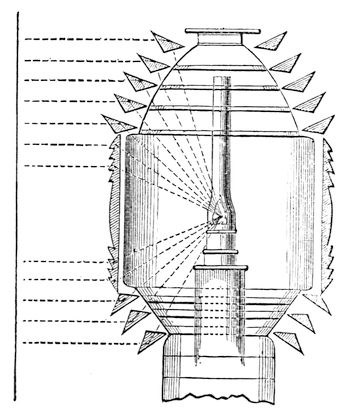
Fig. 57.
There are various orders and sizes of lights in light-houses, to shine for twenty or thirty miles over the sea, and to give indications according to the purposes for which they are required; but suppose we want more effect than is produced by these means, how are we to get more light? Here comes the difficulty. We cannot get more light, because we are limited by the condition of the burner. In any of these cases, if the spreading of the ray, or divergence, as it is called, is not restrained, it soon fails from weakness; and if it does not diverge at all, it makes the light so small, that perhaps only one in a hundred can see it at the same time. The South Foreland light-house is, I think, 300 or 400 feet above the level of the sea; and therefore it is necessary to have a certain divergence of the beam of light, in order that it may shine along the sea to the horizon. I have drawn here two wedges – one has an angle of 15°, and shews you the manner in which the light opens out from this reflector, seen at the distance of half-a-mile or more; the other wedge has an angle of 6°, which is the beautiful angle of Fresnel. When the angle is less than 6°, the mariner is not quite sure that he will see the light – he may be beneath or above it; and, in practice, it is found that we cannot have a larger angle than 15°, or a less one than 6°. In order, therefore, to get more light, we must have more combustion, more cotton, more oil; but already there are in that lamp four wicks, put in concentric rings, one within the other; and we cannot increase them much more, owing to the divergence which would be caused by an increase in the size of the light – the more the divergence, the more the light is diffused and lost. We are therefore restrained, by the condition of the light and the apparatus, to a certain sized lamp. At Teignmouth, some of the revolving lights have ten lamps and reflectors, all throwing their light forward at once. But even with ten lamps and reflectors, we do not get sufficient light; and we want, therefore, a means of getting a light more intense than a candle in the space of a candle – not merely an accumulation of candle upon candle, but a concentration, into the space of a candle, of a greater amount of light; and it is here that the electric light comes to be of so much value.
Let me now shew you what are the properties of that light which make it useful for light-house illumination, and which has been brought to a practical condition by the energy and constancy of Professor Holmes. I will, first of all, shew you the image of the charcoal points on the screen, and draw your attention to the spot where the light is produced. There are the coal points. The two carbons are brought within a certain distance; the electricity is being urged across by the voltaic battery, and the coal points are brought into an intense state of ignition. You will observe that the light is essentially given by the carbons. You see that one is much more luminous than the other, and that is the end which principally forms the spark. The other does not shine so much, and there is a space between the two, which, although not very luminous, is most important to the production of the light. Dr. Tyndall will help me in shewing you that a blast of wind will blow out that light – the electric light can, in fact, be blown out easier than a candle. We have the power of getting our light where we please. If I cause the electricity to pass between carbon and mercury, I get a most intense and beautiful light – most of it being given off from the portion of the mercury between the liquid and the solid pole. I can shew you that the light is sometimes produced by the vapour between the two poles better, if I take silver, than when I use mercury. Here is the carbon pole, there is the silver, and there is the beautiful green light, which comes from the intervening portions. Now, that light is more easily blown out than the common lamp, the slightest puff of wind being sufficient to extinguish it, as you will see if Dr. Tyndall breathes upon it.



